Cooling Performance of a Novel Circulatory Flow Concentric Multi-Channel Heat Sink with Nanofluids
Abstract
1. Introduction
2. Circulatory Flow Multi-Channel Heat Sink
3. Numerical Modelling
3.1. Geometry
3.2. Nanofluid Properties
3.3. Governing Equation and Boundary Conditions
3.4. Numerical Scheme and Validation
4. Discussion
4.1. Flow Field in Heat Sink
4.2. Heat Transfer Enhancement with Nanofluids
5. Conclusions
- (1)
- The maximum local temperature (~77 °C) attained at a low flow rate (30 mL/min) can be reduced to 58, 49.31, and 44.61 °C for flow rates of 60, 120, and 180 mL/min, respectively.
- (2)
- At a lower mass flow rate of 30 mL/min and Q = 50 W, the temperature difference between water outlet temperature and water inlet temperature was approximately 24 °C. This reduced to ~4 °C as the mass flow was increased to 180 mL/min.
- (3)
- A higher rate of heat generation of around 70 W produced a water outlet temperature of ~34 °C for a water flow rate of 30 mL/min. This was reduced to ~5 °C when the water flow was increased.
- (4)
- Heat rejection rate enhanced with nanofluid usage. The enhancement was calculatedby measuring the temperature difference of nanofluid outlet temperature and water outlet temperature under similar operating conditions. The enhancement was ~2% for 0.5% volume fraction nanofluids to ~17% for a 5% volume fraction.
Author Contributions
Funding
Acknowledgments
Conflicts of Interest
References
- Kalteh, M.; Abbassi, A.; Saffar-Avval, M.; Frijns, A.; Darhuber, A.; Harting, J. Experimental and numerical investigation of nanofluid forced convection inside a wide microchannel heat sink. Appl. Therm. Eng. 2012, 36, 260–268. [Google Scholar] [CrossRef]
- Tuckerman, D.B.; Pease, R.F.W. High-performance heat sinking for VLSI. IEEE Electron. Device Lett. 1981, 2, 126–129. [Google Scholar] [CrossRef]
- Wang, B.X.; Peng, X.F. Experimental investigation on liquid forced-convection heat transfer through microchannels. Int. J. Heat Mass Transfer. 1994, 37, 73–82. [Google Scholar] [CrossRef]
- Xie, X.L.; Liu, Z.J.; He, Y.L.; Tao, W.Q. Numerical study of laminar heat transfer and pressure drop characteristics in a water-cooled mini channel heat sink. Appl. Therm. Eng. 2009, 29, 64–74. [Google Scholar] [CrossRef]
- Steinke, M.E.; Kandlikar, S.G. Review of single-phase heat transfer enhancement techniques for application in microchannels, mini-channels and microdevices. Heat Technol. 2004, 22, 3–11. [Google Scholar]
- Steinke, M.E.; Kandlikar, S.G. Single-phase liquid heat transfer in plain and enhanced Micro-channels. In Proceedings of the ICNMM2006, Fourth International Conference on Nanochannels, Microchannels and Minichannels, Limerick, Ireland, 19–21 June 2006. [Google Scholar]
- Khameneh, P.M.; Mirzaie, I.; Pourmahmoud, N.; Majidyfar, S. A numerical study of single-phase forced convective heat transfer with flow friction in microchannels. Int. J. Eng. Trans. A 2012, 25, 79–87. [Google Scholar] [CrossRef]
- Hasan, M.I.; Rageb, A.A.; Yaghoubi, M.; Homayoni, H. Influence of channel geometry on the performance of counter flow microchannel heat exchanger. Int. J. Therm. Sci. 2009, 48, 1607–1618. [Google Scholar] [CrossRef]
- Jiang, P.; Xu, R. Heat transfer and pressure drop characteristics of mini-fin structures. Int. J. Heat Fluid Flow 2007, 28, 1167–1177. [Google Scholar] [CrossRef]
- Ahmed, H.E.; Ahmed, M.I. Optimum thermal design of triangular, trapezoidal and rectangular grooved microchannel heat sinks. Int. Commun. Heat Mass Transfer 2015, 66, 47–57. [Google Scholar] [CrossRef]
- Choi, J.T.; Kwon, O.K. A numerical study of the heat transfer and fluid flow micro-channeled water block for computer CPU cooling. J. Mech. Sci. Technol. 2015, 25, 2657–2663. [Google Scholar] [CrossRef]
- Saad, A.J.; Wajahat, A.; Hafiz, M.; Aysha, M. Water cooled mini-channel heat sinks for microprocessor cooling: Effect of fin spacing. Appl. Therm. Eng. 2014, 64, 76–82. [Google Scholar]
- Liu, J. Numerical study on performances of mini-channel heat sinks within-uniform inlets. Appl. Therm. Eng. 2016, 9, 856–864. [Google Scholar] [CrossRef]
- Khoshvaght-Aliabadi, M.; Sahamiyan, M.; Hesampour, M.; Sartipzadeh, O. Experimental study on cooling performance of sinusoidal–wavy minichannel heat sink. Appl. Therm. Eng. 2016, 9, 50–61. [Google Scholar] [CrossRef]
- Lee, P.-S.; Garimella, S.; Liu, D. Investigation of heat transfer in rectangular microchannels. Int. J. Heat Mass Transfer 2008, 48, 1688–1704. [Google Scholar] [CrossRef]
- Cairone, F.; Gagliano, S.; Bucolo, M. Experimental study on the slug flow in a serpentine microchannel. Exp. Therm. Fluid Sci. 2016, 76, 34–44. [Google Scholar] [CrossRef]
- Fazeli, S.A.; Hashemi, S.M.H.; Zirakzadeh, H.; Ashjaee, M. Experimental and numerical investigation of heat transfer in a miniature heat sink utilizing silica nanofluid. Superlattices Microstruct. 2012, 51, 247–264. [Google Scholar] [CrossRef]
- Lee, S.; Choi, S.U.S.; Li, S.; Eastman, J.A. Measuring thermal conductivity of fluids containing oxide nanoparticles. ASME J. Heat Transfer 1999, 121, 280–289. [Google Scholar] [CrossRef]
- Wang, B.X.; Zhou, L.P.; Peng, X.F. A fractal model for predicting the effective thermal conductivity of liquid with suspension of nanoparticles. Int. J. Heat Mass Transfer 2003, 46, 2665–2672. [Google Scholar] [CrossRef]
- Koo, J.; Kleinstreuer, C. A new thermal conductivity model for nanofluids. J. Nanopart. Res. 2004, 6, 577–588. [Google Scholar] [CrossRef]
- Choi, S.U.S.; Zhang, Z.G.; Yu, W.; Lockwood, F.E.; Grulke, E.A. Anomalous thermal conductivity enhancement in nanotube suspensions. Appl. Phys. Lett. 2001, 7, 2252–2254. [Google Scholar] [CrossRef]
- Duangthongsuk, W.; Wongwises, S. Comparison of the effects of measured and computed thermophysical properties of nanofluids on heat transfer performance. Exp. Therm. Fluid Sci. 2010, 34, 616–624. [Google Scholar] [CrossRef]
- Ho, C.J.; Wei, L.C.; Li, Z.W. An experimental investigation of forced convective cooling performance of a microchannel heat sink with Al2O3/water nanofluid. Appl. Therm. Eng. 2010, 30, 96–103. [Google Scholar] [CrossRef]
- Koo, J.; Kleinstreuer, C. Laminar nanofluid flow in micro heat-sinks. Int. J. Heat Mass Transfer 2005, 48, 2652–2661. [Google Scholar] [CrossRef]
- Jang, S.P.; Choi, S. Cooling performance of a microchannel heat sink with nanofluids. Appl. Therm. Eng. 2006, 26, 2457–2463. [Google Scholar] [CrossRef]
- Ijam, A.; Saidur, R. Nanofluid as a coolant for electronic devices (cooling of electronic devices). Appl. Therm. Eng. 2012, 32, 76–82. [Google Scholar] [CrossRef]
- Pak, B.C.; Cho, Y.I. Hydrodynamic and heat transfer study of dispersed fluids with submicron metallic oxide particles. Exp. Heat Transfer 1998, 11, 151–170. [Google Scholar] [CrossRef]
- Khanafer, K.; Vafai, K. A critical synthesis of thermophysical characteristics of nanofluids. Int. J. Heat Mass Transf. 2011, 54, 4410–4428. [Google Scholar] [CrossRef]
- Ghasemi, B.; Aminossadati, S.M. Natural convection heat transfer in an inclined enclosure filled with a water-CuO nanofluid. Numer. Heat Transfer Part A 2009, 55, 807–823. [Google Scholar] [CrossRef]
- Einstein, A. Investigation on the Theory of Brownian Movement; Courier Corporation: New York, NY, USA, 1956. [Google Scholar]
- Heris, S.Z.; Esfahany, M.N.; Etemad, S.G. Experimental investigation of convective heat transfer of Al2O3/water nanofluid in circular tube. Int. J. Heat Fluid Flow 2007, 28, 203–210. [Google Scholar] [CrossRef]
- Yu, W.; Choi, S.U.S. The role of international layers in the enhanced thermal conductivity of nanofluids: A renovated Maxwell model. J. Nanopart. Res. 2003, 5, 167–171. [Google Scholar] [CrossRef]
- Trisaksri, V.; Wongwises, S. Critical review of heat transfer characteristics nanofluids. Renew Sustain. Energy Rev. 2007, 11, 512–523. [Google Scholar] [CrossRef]
- Ghasemi, B.; Aminossadati, S.M. A numerical study on the forced convection of laminar nanofluid in a micro channel with both slip and no slip conditions. Numer. Heat Transfer Part A 2011, 59, 114–129. [Google Scholar]
- Xuan, Y.; Roetzel, W. Conceptions for heat transfer correlation of nanofluids. Int. J. Heat Mass Transf. 2000, 43, 3701–3707. [Google Scholar] [CrossRef]
- Yang, Y.-T.; Lai, F.-H. Numerical study of heat transfer enhancement with the use of nanofluids in radial flow cooling system. Int. J. Heat Mass Transf. 2010, 53, 5895–5904. [Google Scholar] [CrossRef]
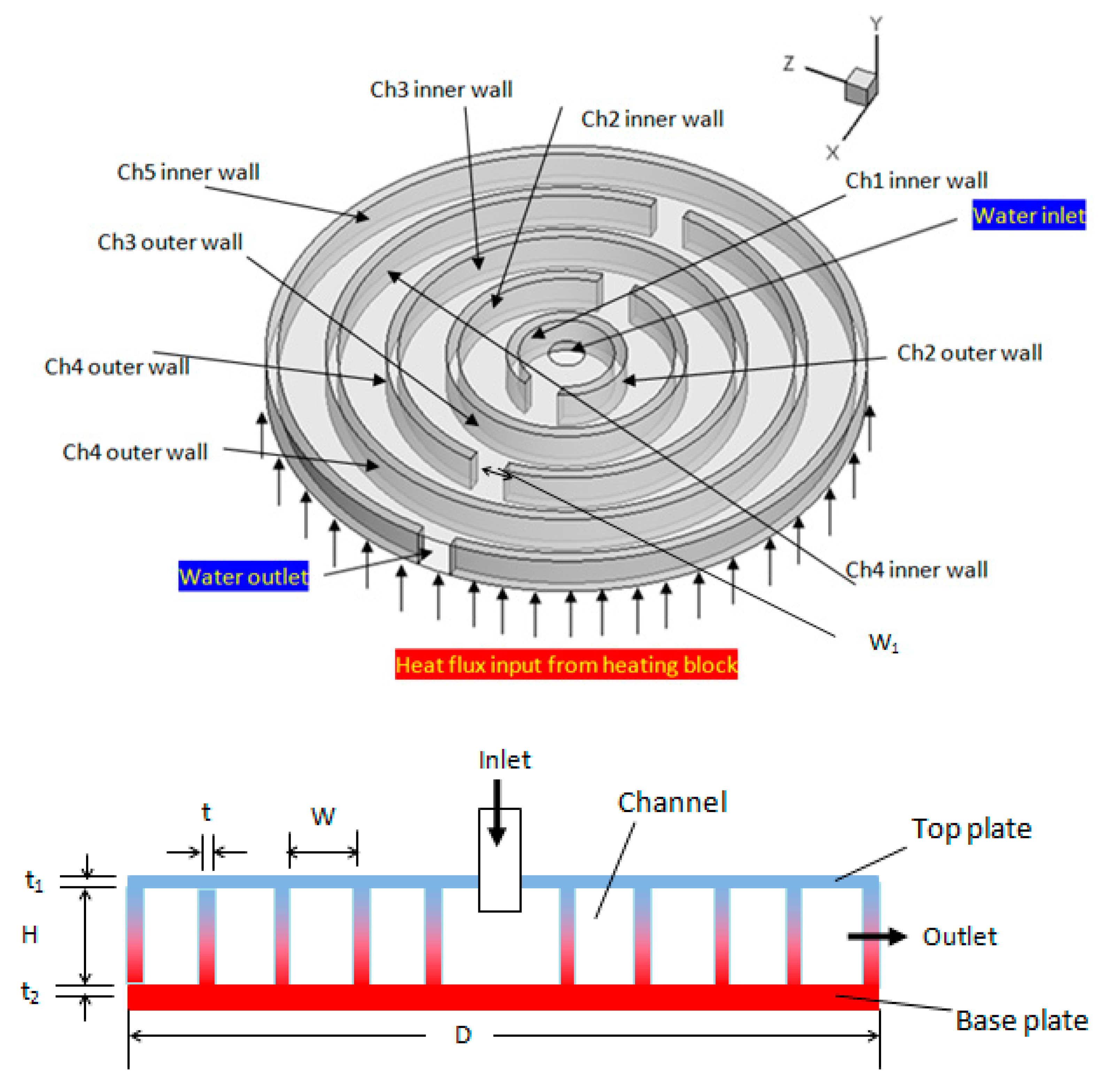
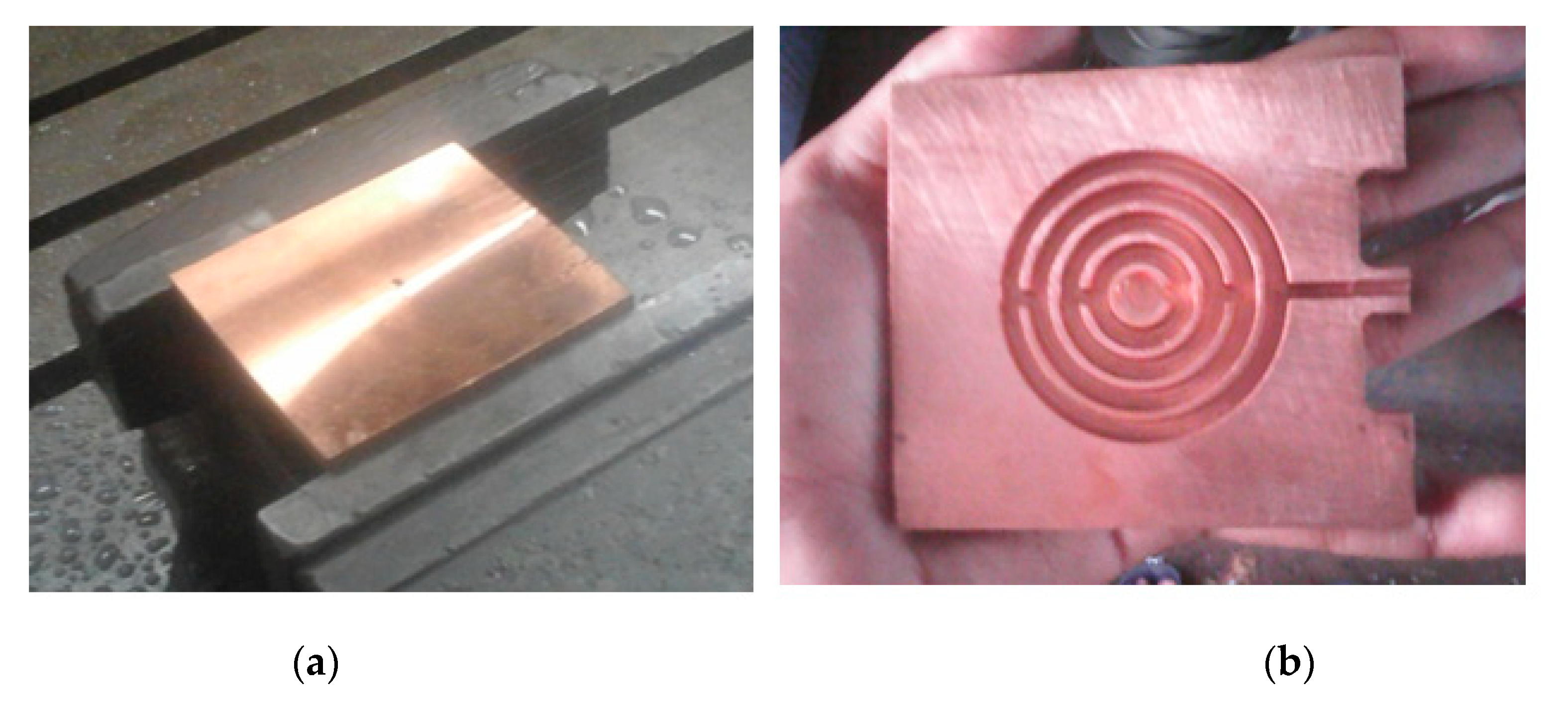
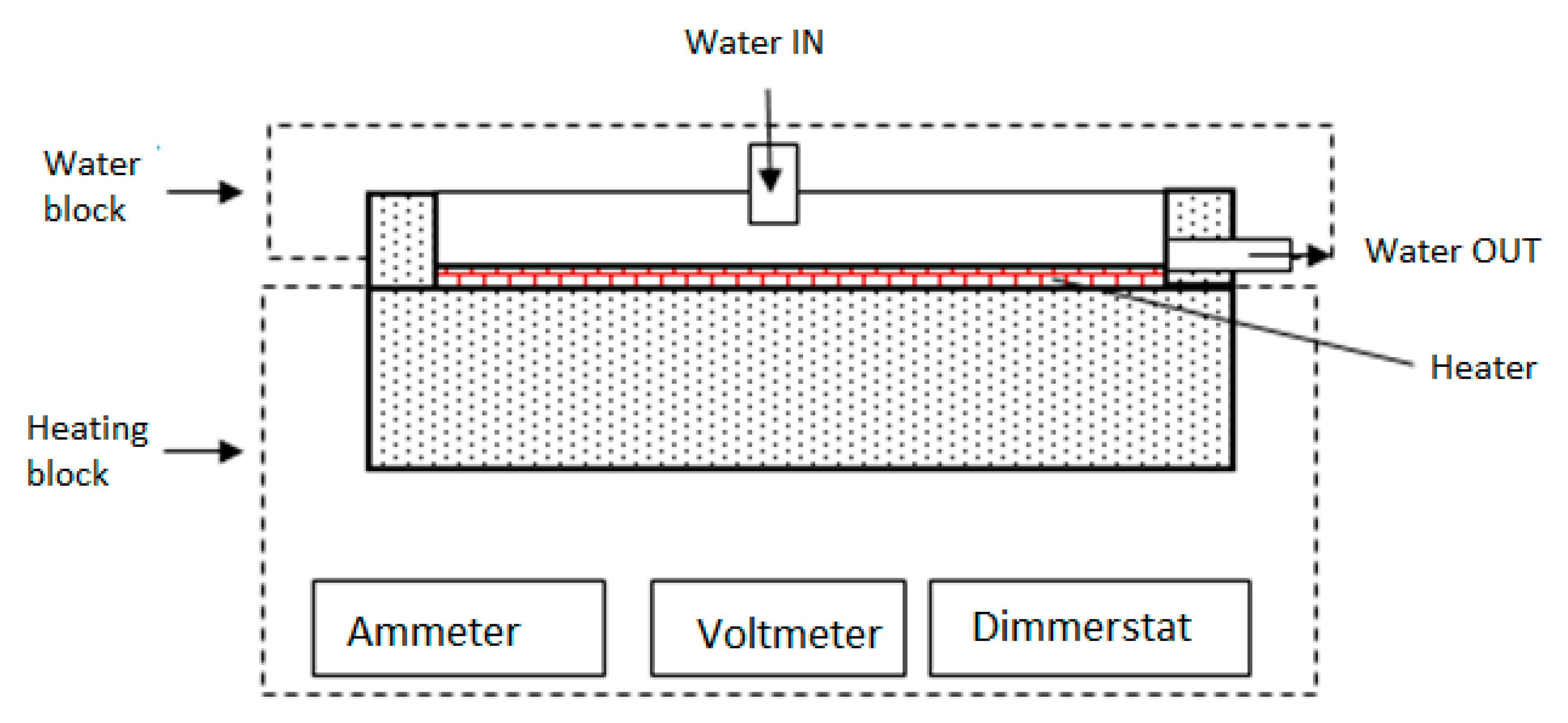
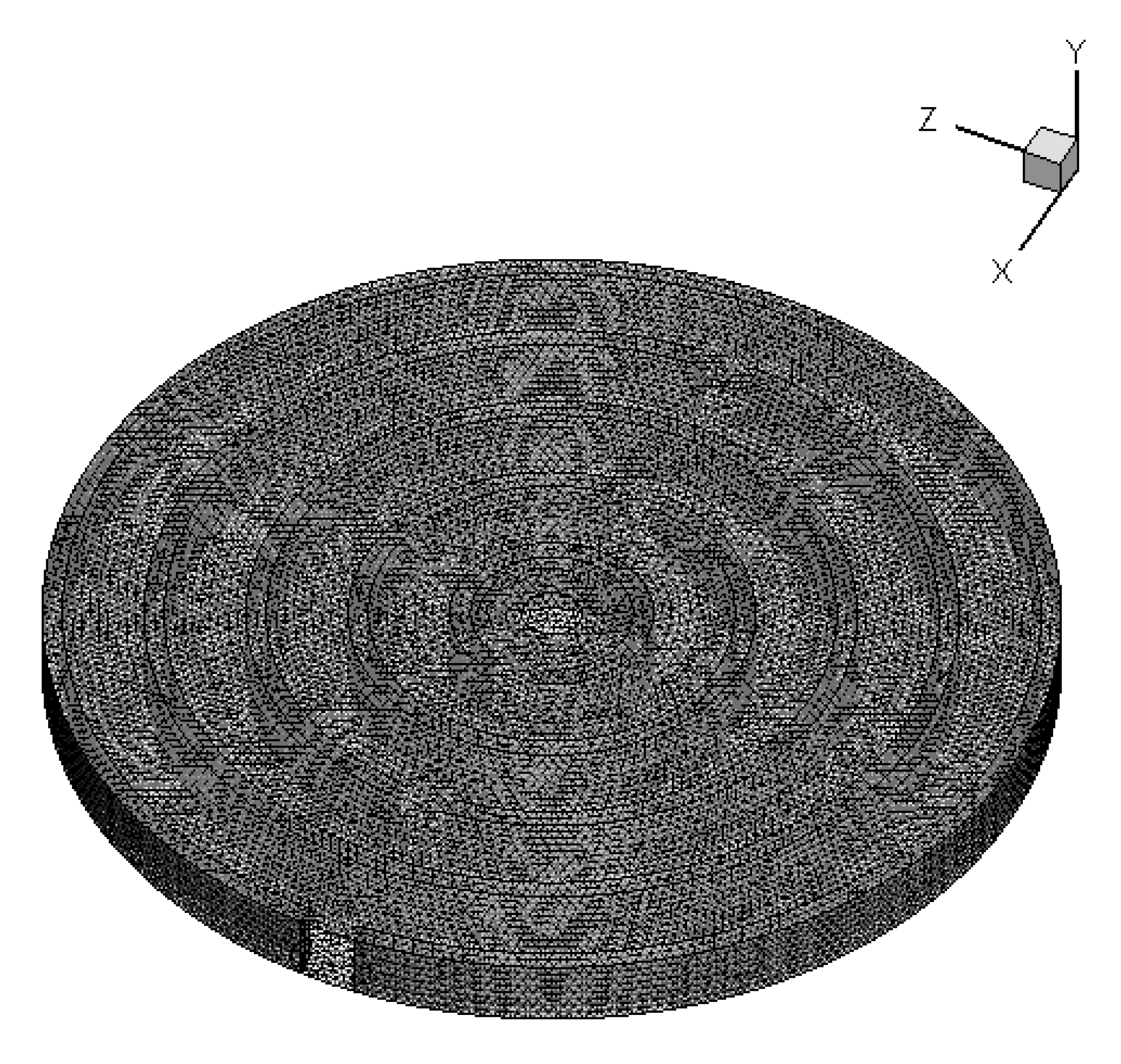
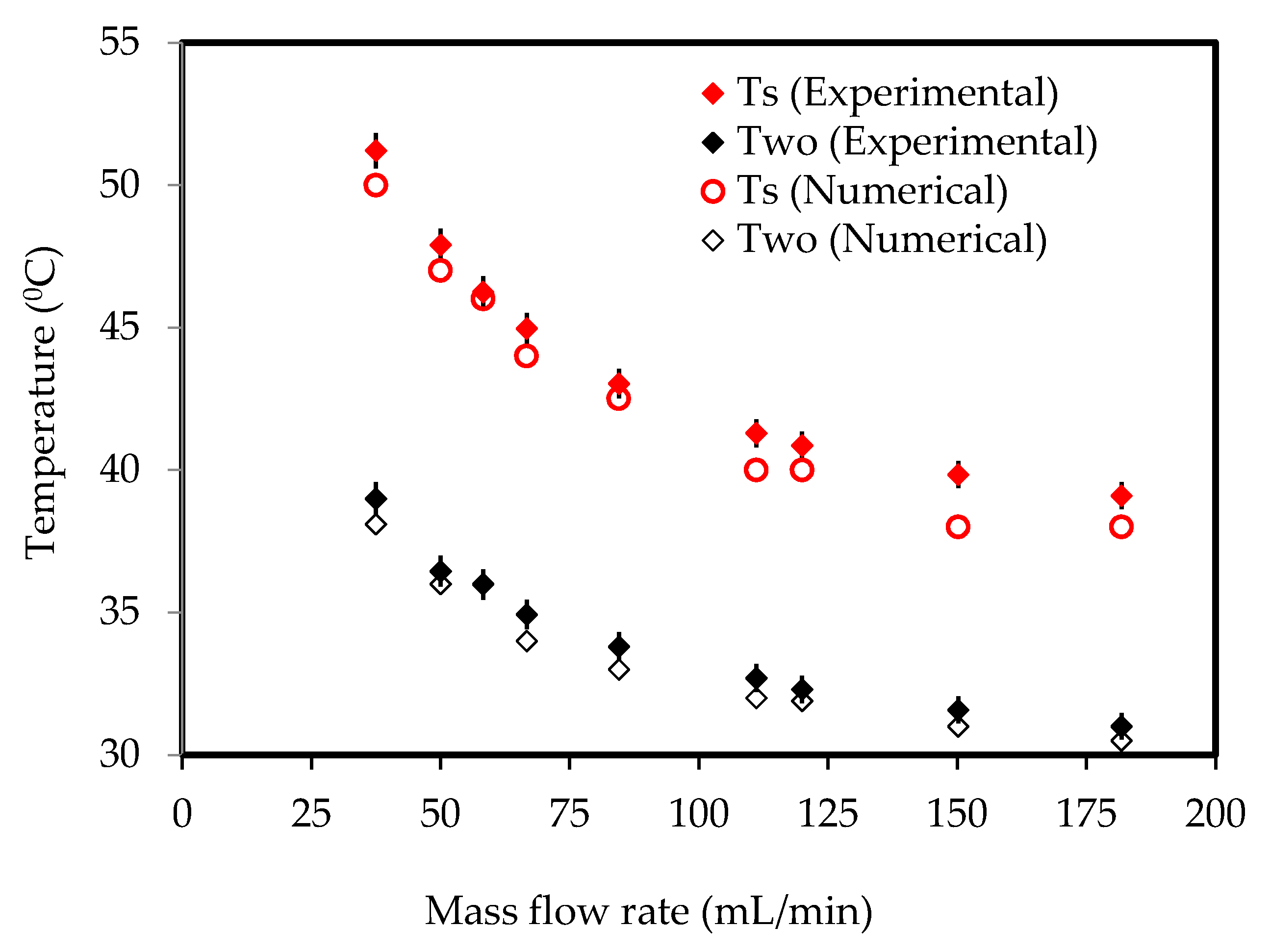

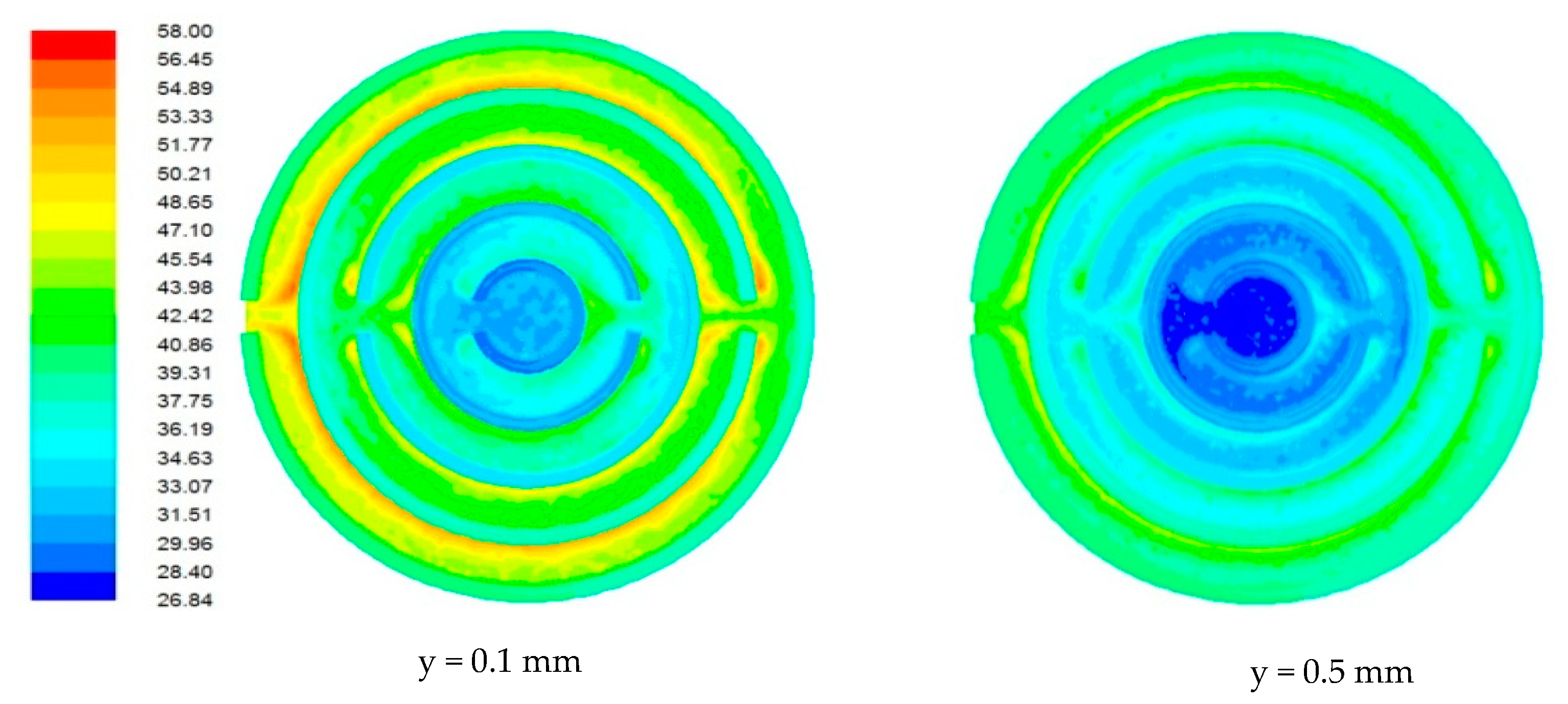
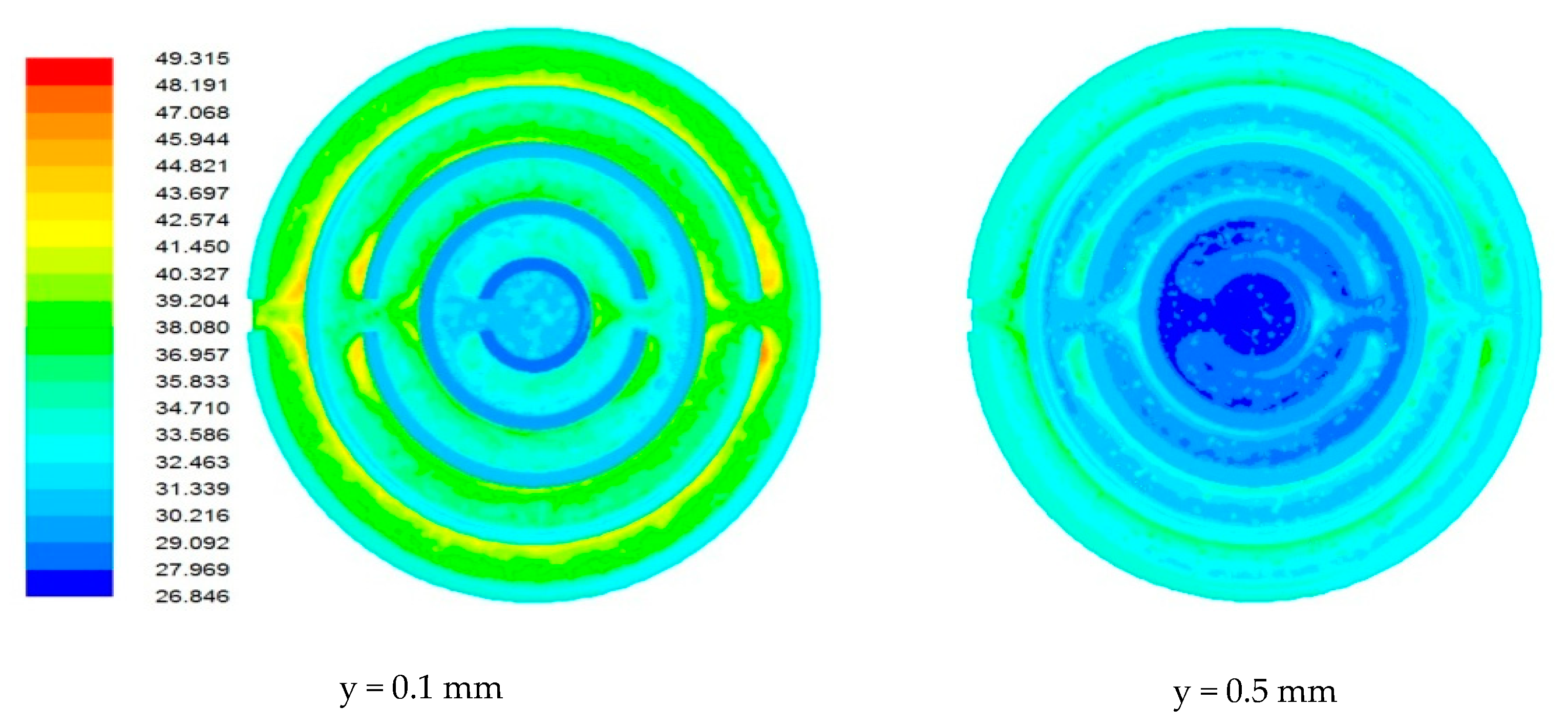
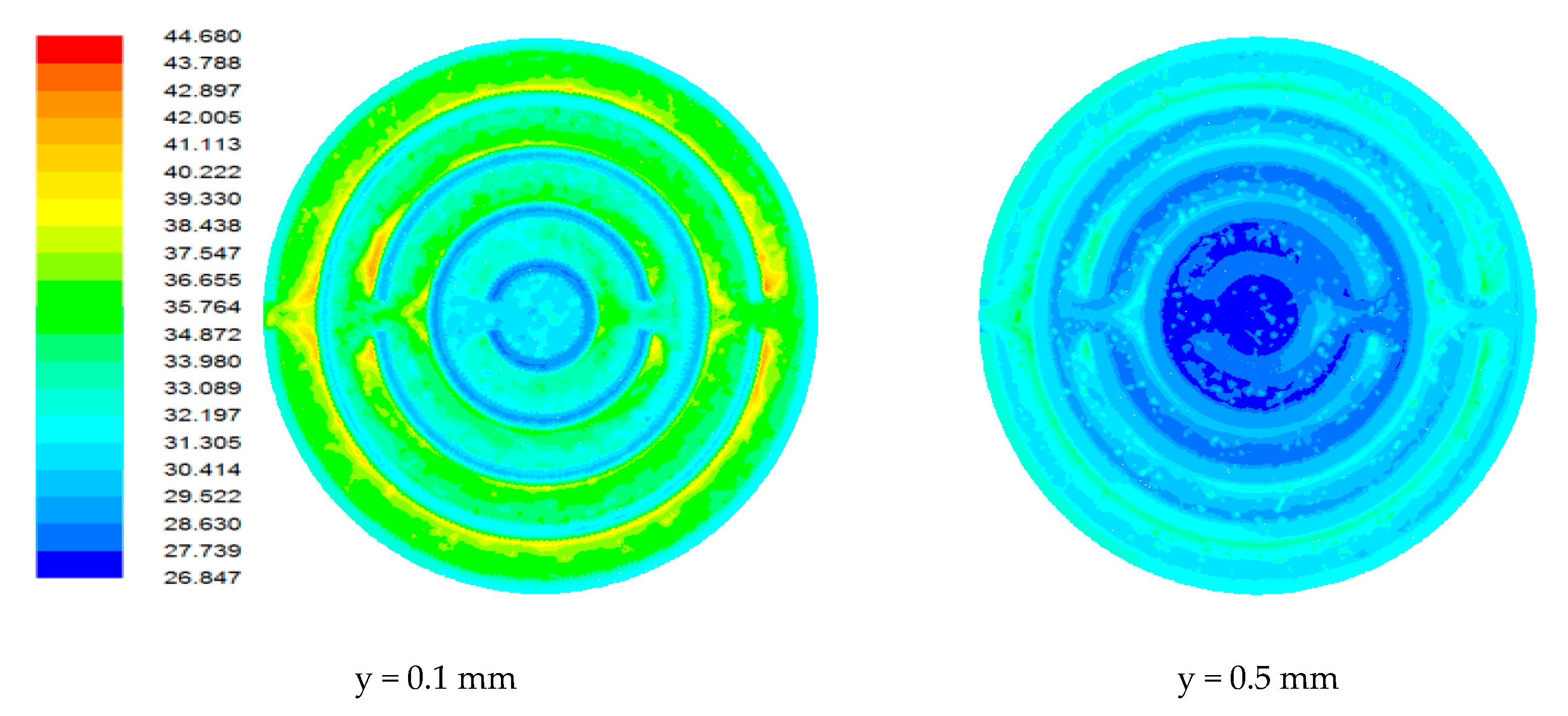
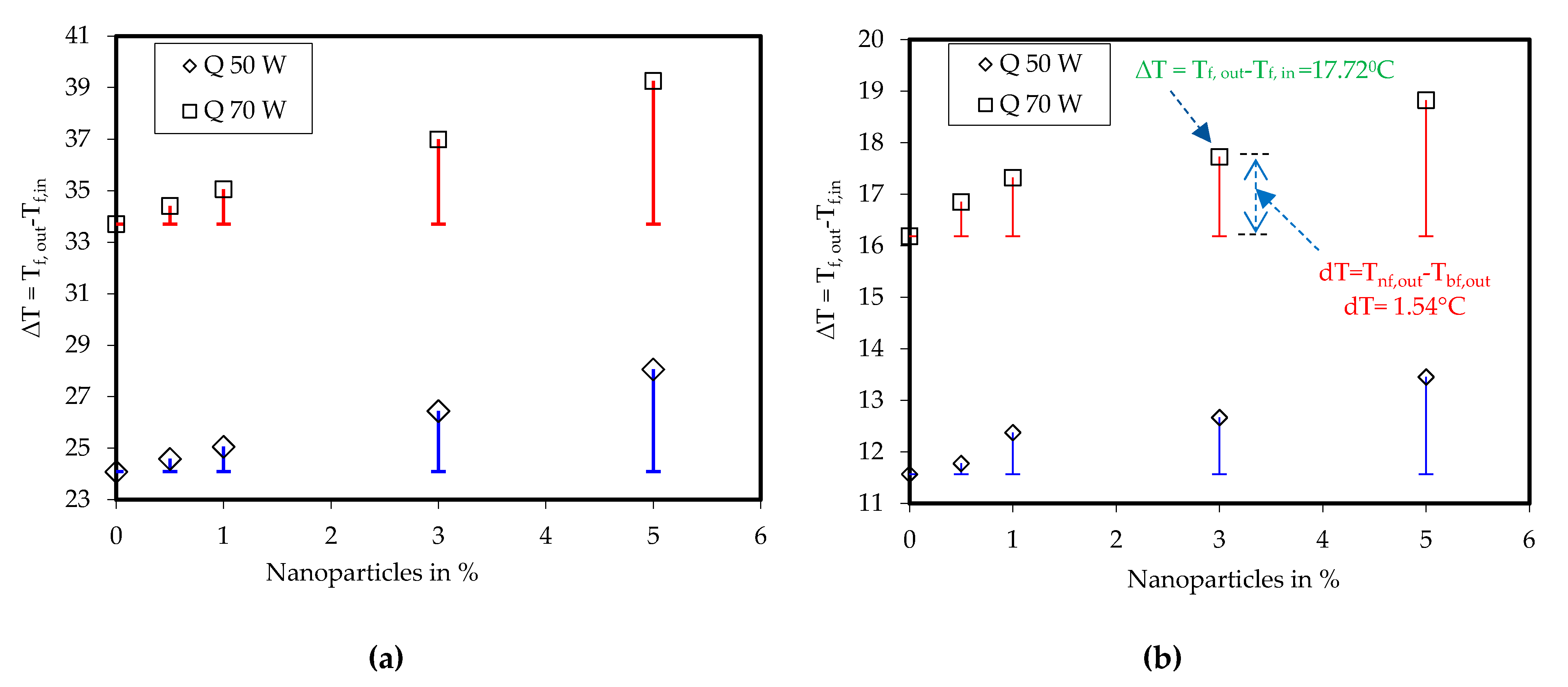
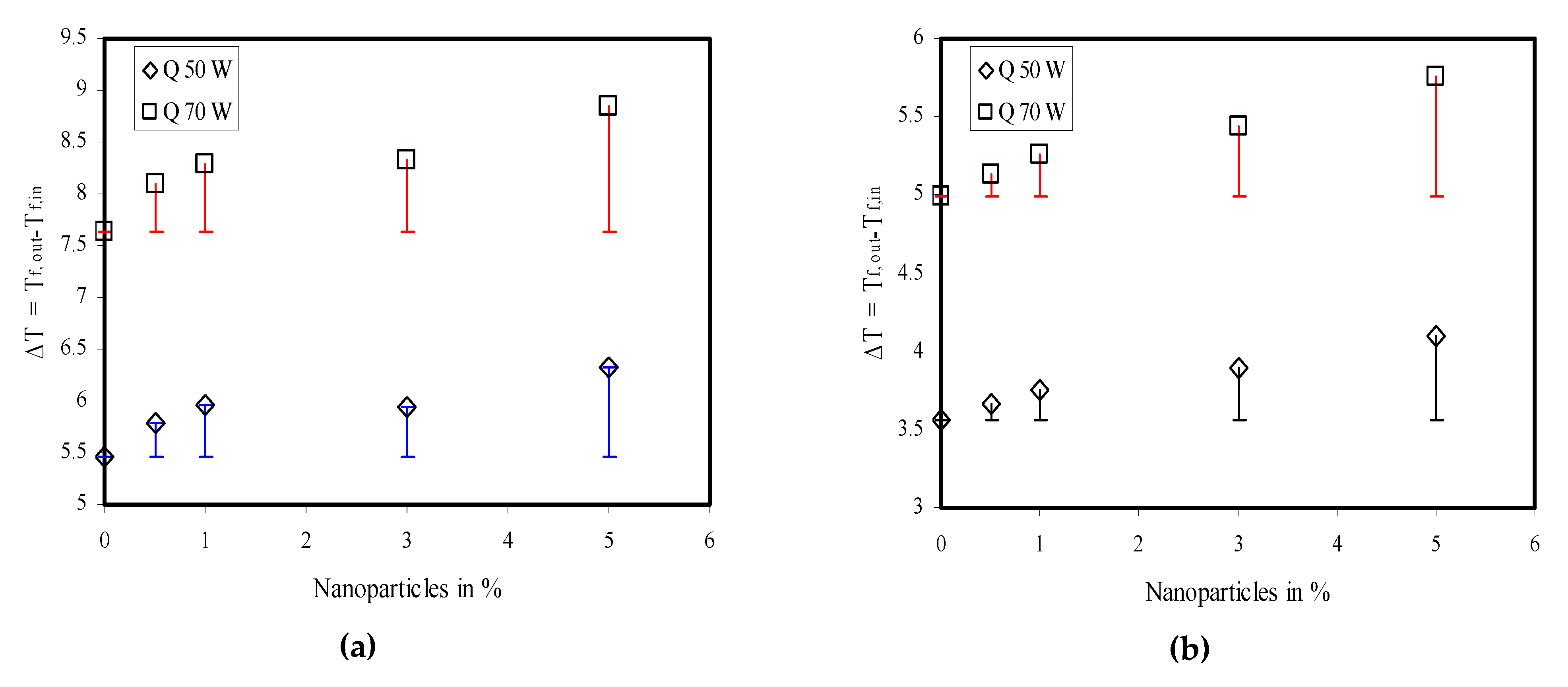
| Parameters | Size, mm |
|---|---|
| Diameter of heat sink (D) | 50 |
| Height of channel (H) | 3.5 |
| Width of channel (W) | 4 |
| Thickness of channel wall (t) | 1 |
| Thickness of heat sink base plate (t2) | 2 |
| Thickness of heat sink cover plate (t1) | 1 |
| Total height of heat sink (H + t1 + t2) | 5.5 |
| Flow passage slot for the water to flow (W1) | 3 |
| Dimensions of the water outlet duct (W1× H) | 3 × 3.5 |
| Width of the slots (passage) | 3 |
| Properties | Pure Water | Alumina (Al2O3) |
|---|---|---|
| Mass density, kg/m3 | 995.81 | 3880 |
| Specific heat, J/kgK | 4178 | 765 |
| Thermal conductivity, W/mK | 0.6172 | 40 |
| Viscosity, kg/ms | 0.0008034 | − |
© 2020 by the authors. Licensee MDPI, Basel, Switzerland. This article is an open access article distributed under the terms and conditions of the Creative Commons Attribution (CC BY) license (http://creativecommons.org/licenses/by/4.0/).
Share and Cite
Jilte, R.; Ahmadi, M.H.; Kumar, R.; Kalamkar, V.; Mosavi, A. Cooling Performance of a Novel Circulatory Flow Concentric Multi-Channel Heat Sink with Nanofluids. Nanomaterials 2020, 10, 647. https://doi.org/10.3390/nano10040647
Jilte R, Ahmadi MH, Kumar R, Kalamkar V, Mosavi A. Cooling Performance of a Novel Circulatory Flow Concentric Multi-Channel Heat Sink with Nanofluids. Nanomaterials. 2020; 10(4):647. https://doi.org/10.3390/nano10040647
Chicago/Turabian StyleJilte, Ravindra, Mohammad H. Ahmadi, Ravinder Kumar, Vilas Kalamkar, and Amirhosein Mosavi. 2020. "Cooling Performance of a Novel Circulatory Flow Concentric Multi-Channel Heat Sink with Nanofluids" Nanomaterials 10, no. 4: 647. https://doi.org/10.3390/nano10040647
APA StyleJilte, R., Ahmadi, M. H., Kumar, R., Kalamkar, V., & Mosavi, A. (2020). Cooling Performance of a Novel Circulatory Flow Concentric Multi-Channel Heat Sink with Nanofluids. Nanomaterials, 10(4), 647. https://doi.org/10.3390/nano10040647







